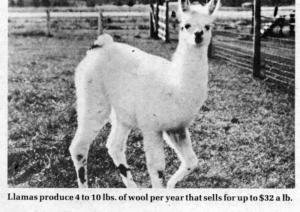1982 - Volume #6, Issue #3, Page #19
[ Sample Stories From This Issue | List of All Stories In This Issue | Print this story
| Read this issue]
Oregon Ranch Raises Lots of Llamas
 |
Although his chief business is raising Polish Arabian horses, Patterson has always had a soft spot in his heart for llamas. He estimates there are some 2,500 llamas in the U.S. and Canada, with about 800 in zoos and safari parks. The rest are privately owned.
Since it has been illegal for the past 40-50 years to import llamas from their native South America, private owners have a seller's market. Patterson has buyers on waiting lists for llamas, at prices up to $5,000 for an adult pair.
In North America, llamas are raised for pets, wool, pack animals and as curiosities. They grow to be 3 to 4 ft. tall and weigh between 350 and 500 lbs. They live an average of 16 years, according to Patterson.
Although best adapted to high elevations, llamas do adjust well to lower elevations. They'll also adapt to hot, cold, dry or wet climates.
Llamas are generally friendlier and more cooperative than their distant relative, the camel. Like camels, they use spitting as a means of self-defense, but only rarely. "Their disposition is calm and stable," Patterson explains. "Under normal conditions, they will not bite, kick or spit.
"Llamas are ruminants and adapt readily to local feeds. Hay or pasture are about all they really need, along with plenty of fresh water and a trace-mineral salt block," he notes.
Wool production from llamas is 4 to 10 lbs. per year and sells for up to $32 a pound to craftsman, spinners and weavers looking for something different. Llama raisers who do sell wool usually leave an inch or more on the skin to protect the animal from the sun.
Health problems are practically non-existent in llama herds. "Llamas are disease resistant, although we occasionally lose a llama from a cold or pneumonia," Patterson told FARM SHOW.
Patterson keeps a stud book and complete records on his llamas to prevent inbreeding. He has a number of separate blood lines and names all his llamas after movie stars to make record-keeping easier.
"Sheep raisers like llamas because of their anti-predator stance. They band together to run at attacking coyotes and dogs to scare them away. A few sheep raisers have put llamas in with their flocks as protection. It must be a small pasture, though, so the llamas will stay within sight of the sheep," Patterson points out.
For more information, contact: FARM SHOW Followup, Patterson Llamas, Box 188, Sisters, Ore. 97759 (ph 503 549-3831).

Click here to download page story appeared in.

Click here to read entire issue
To read the rest of this story, download this issue below or click here to register with your account number.




